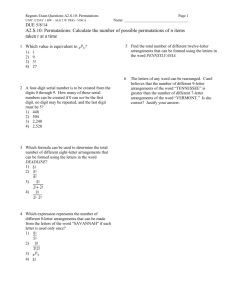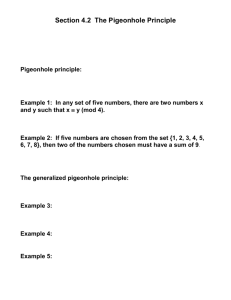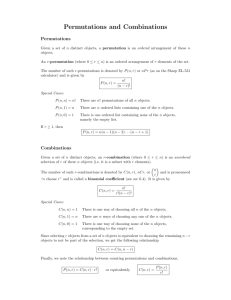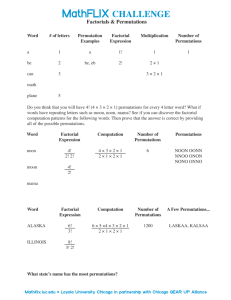1.2: Permutations
advertisement
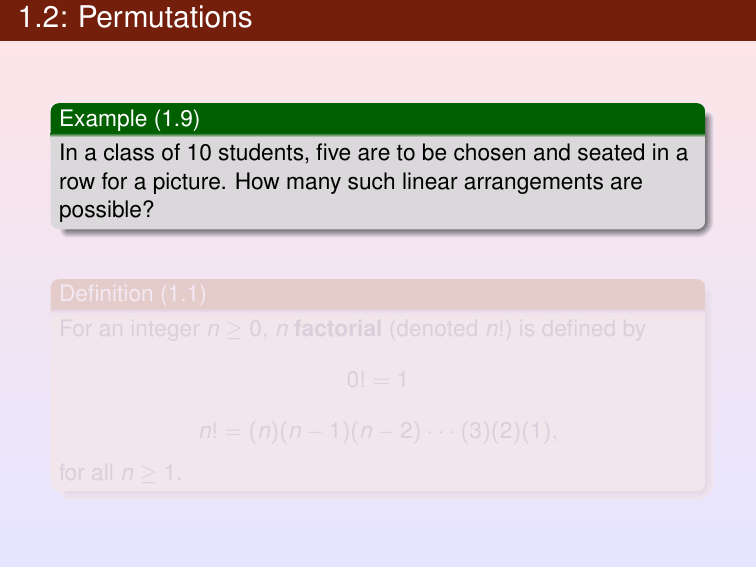
1.2: Permutations Example (1.9) In a class of 10 students, five are to be chosen and seated in a row for a picture. How many such linear arrangements are possible? Definition (1.1) For an integer n ≥ 0, n factorial (denoted n!) is defined by 0! = 1 n! = (n)(n − 1)(n − 2) · · · (3)(2)(1), for all n ≥ 1. 1.2: Permutations Example (1.9) In a class of 10 students, five are to be chosen and seated in a row for a picture. How many such linear arrangements are possible? Definition (1.1) For an integer n ≥ 0, n factorial (denoted n!) is defined by 0! = 1 n! = (n)(n − 1)(n − 2) · · · (3)(2)(1), for all n ≥ 1. 1.2: Permutations Definition (1.2) Given a collection of n distinct objects, any (linear) arrangement of these objects is called a permutation of the collection. Formula and Notation If there are n distinct objects and r is an integer, with 1 ≤ r ≤ n, then by the rule of product, the number of permutations of size r for the n objects is P(n, r ) = n × (n − 1) × (n − 2) × · · · × (n − r + 1) = (n)(n − 1)(n − 2) · · · (n − r + 1)× (n − r )(n − r − 1) · · · (3)(2)(1) (n − r )(n − r − 1) · · · (3)(2)(1) n! = . (n − r )! 1.2: Permutations Definition (1.2) Given a collection of n distinct objects, any (linear) arrangement of these objects is called a permutation of the collection. Formula and Notation If there are n distinct objects and r is an integer, with 1 ≤ r ≤ n, then by the rule of product, the number of permutations of size r for the n objects is P(n, r ) = n × (n − 1) × (n − 2) × · · · × (n − r + 1) = (n)(n − 1)(n − 2) · · · (n − r + 1)× (n − r )(n − r − 1) · · · (3)(2)(1) (n − r )(n − r − 1) · · · (3)(2)(1) n! = . (n − r )! 1.2: Permutations The number of permutations of size r , where 0 ≤ r ≤ n, from a collection of n objects, is P(n, r ) = n!/(n − r )!. (Remember that P(n, r ) counts (linear) arrangements in which the objects cannot be repeated.) However, if repetition are allowed, then by the rule of product there are nr possible arrangements, with r ≥ 0. Example (1.10) The number of permutatuion of the letters in the word COMPUTER is 8!. If only five of the letters are used, the number of permutations (of size 5) is P(n, r ) = 8!/(8 − 5)! = 8!/3! = 6720. If repetition of letters are allowed, the number of possible 12-letter sequences is . 812 = 6.872 × 1010 . 1.2: Permutations The number of permutations of size r , where 0 ≤ r ≤ n, from a collection of n objects, is P(n, r ) = n!/(n − r )!. (Remember that P(n, r ) counts (linear) arrangements in which the objects cannot be repeated.) However, if repetition are allowed, then by the rule of product there are nr possible arrangements, with r ≥ 0. Example (1.10) The number of permutatuion of the letters in the word COMPUTER is 8!. If only five of the letters are used, the number of permutations (of size 5) is P(n, r ) = 8!/(8 − 5)! = 8!/3! = 6720. If repetition of letters are allowed, the number of possible 12-letter sequences is . 812 = 6.872 × 1010 . 1.2: Permutations The number of permutations of size r , where 0 ≤ r ≤ n, from a collection of n objects, is P(n, r ) = n!/(n − r )!. (Remember that P(n, r ) counts (linear) arrangements in which the objects cannot be repeated.) However, if repetition are allowed, then by the rule of product there are nr possible arrangements, with r ≥ 0. Example (1.10) The number of permutatuion of the letters in the word COMPUTER is 8!. If only five of the letters are used, the number of permutations (of size 5) is P(n, r ) = 8!/(8 − 5)! = 8!/3! = 6720. If repetition of letters are allowed, the number of possible 12-letter sequences is . 812 = 6.872 × 1010 . 1.2: Permutations The number of permutations of size r , where 0 ≤ r ≤ n, from a collection of n objects, is P(n, r ) = n!/(n − r )!. (Remember that P(n, r ) counts (linear) arrangements in which the objects cannot be repeated.) However, if repetition are allowed, then by the rule of product there are nr possible arrangements, with r ≥ 0. Example (1.10) The number of permutatuion of the letters in the word COMPUTER is 8!. If only five of the letters are used, the number of permutations (of size 5) is P(n, r ) = 8!/(8 − 5)! = 8!/3! = 6720. If repetition of letters are allowed, the number of possible 12-letter sequences is . 812 = 6.872 × 1010 . 1.2: Permutations The number of permutations of size r , where 0 ≤ r ≤ n, from a collection of n objects, is P(n, r ) = n!/(n − r )!. (Remember that P(n, r ) counts (linear) arrangements in which the objects cannot be repeated.) However, if repetition are allowed, then by the rule of product there are nr possible arrangements, with r ≥ 0. Example (1.10) The number of permutatuion of the letters in the word COMPUTER is 8!. If only five of the letters are used, the number of permutations (of size 5) is P(n, r ) = 8!/(8 − 5)! = 8!/3! = 6720. If repetition of letters are allowed, the number of possible 12-letter sequences is . 812 = 6.872 × 1010 . 1.2: Permutations Permutations with repeated objects: Formula If there are n objects with n1 indistinguishable objects of a first type, n2 indistinguishable objects of a second type, · · · , and nr indistinguishable objects of an r th type, where n! n1 + n2 + · · · + nr = n, then there are (linear) n1 !n2 ! · · · nr ! arrangements of the given n objects. 1.2: Permutations Permutations with repeated objects: Formula If there are n objects with n1 indistinguishable objects of a first type, n2 indistinguishable objects of a second type, · · · , and nr indistinguishable objects of an r th type, where n! n1 + n2 + · · · + nr = n, then there are (linear) n1 !n2 ! · · · nr ! arrangements of the given n objects. 1.2: Permutations Example (1.13) The MASSASAUGA is a brown and white venomous snake indigenous to North America. Arranging all of the letters in MASSASAUGA, we find that there are 10! = 25200 4!3!1!1!1! possible arrangements. If all four A’s are together? For this question, we considered all arrangements of the seven symbols AAAA(one symbol), S, S, 7! S, M, U, G. So, the answer is 3!1!1!1!1! = 840. 1.2: Permutations Example (1.13) The MASSASAUGA is a brown and white venomous snake indigenous to North America. Arranging all of the letters in MASSASAUGA, we find that there are 10! = 25200 4!3!1!1!1! possible arrangements. If all four A’s are together? For this question, we considered all arrangements of the seven symbols AAAA(one symbol), S, S, 7! S, M, U, G. So, the answer is 3!1!1!1!1! = 840. 1.2: Permutations Example (1.13) The MASSASAUGA is a brown and white venomous snake indigenous to North America. Arranging all of the letters in MASSASAUGA, we find that there are 10! = 25200 4!3!1!1!1! possible arrangements. If all four A’s are together? For this question, we considered all arrangements of the seven symbols AAAA(one symbol), S, S, 7! = 840. S, M, U, G. So, the answer is 3!1!1!1!1! 1.2: Permutations Example (1.13) The MASSASAUGA is a brown and white venomous snake indigenous to North America. Arranging all of the letters in MASSASAUGA, we find that there are 10! = 25200 4!3!1!1!1! possible arrangements. If all four A’s are together? For this question, we considered all arrangements of the seven symbols AAAA(one symbol), S, S, 7! = 840. S, M, U, G. So, the answer is 3!1!1!1!1! 1.2: Permutations Example (1.15) Prove that if n and k are positive integers with n = 2k, then n!/2k is an integer. Example (1.16) If six people are seated about a round table, how many different circular arrangements are possible, if arrangements are considered the same when one can be obtained from the other by rotation. Example (1.17) Suppose that the six people of example 1.16 are three married couples. We want to arrange the six people around the table so that the sexes alternate. 1.2: Permutations Example (1.15) Prove that if n and k are positive integers with n = 2k, then n!/2k is an integer. Example (1.16) If six people are seated about a round table, how many different circular arrangements are possible, if arrangements are considered the same when one can be obtained from the other by rotation. Example (1.17) Suppose that the six people of example 1.16 are three married couples. We want to arrange the six people around the table so that the sexes alternate. 1.2: Permutations Example (1.15) Prove that if n and k are positive integers with n = 2k, then n!/2k is an integer. Example (1.16) If six people are seated about a round table, how many different circular arrangements are possible, if arrangements are considered the same when one can be obtained from the other by rotation. Example (1.17) Suppose that the six people of example 1.16 are three married couples. We want to arrange the six people around the table so that the sexes alternate.

